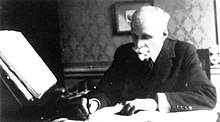Maurice Emmanuel

Maurice Emmanuel (2 May 1862 – 14 December 1938) was a French composer of classical music born in Bar-sur-Aube,[1] a small town in the Champagne-Ardenne region of northeastern France. It was there where he first heard his grandfather's printing press which according to his grand-daughter, Anne Eichner-Emmanuel, first gave him the feeling of rhythm.[2]
Brought up in Dijon, Marie François Maurice Emmanuel became a chorister at Beaune cathedral after his family moved to the city in 1869. According to his grand-daughter, Anne Eichner-Emmanuel, he was influenced by the brass bands on the streets of Beaune and by the "songs of the grape pickers which imprinted melodies in his memory so different from all the classical music he was taught in the academy of music."[3] Subsequently he went to Paris, and he entered the Paris Conservatoire, where his composition teacher was Léo Delibes. However, Delibes' strong disapproval of his early modal compositions (Cello Sonata, Op. 2, Sonatinas No. 1, Op. 4 and No. 2, Op. 5)[4] caused a rift between them and subsequently caused him to study with Ernest Guiraud also at the Conservatoire.[5][6][7] At the Conservatoire he came to know Claude Debussy who was also a pupil there. In addition, he attended the Conservatoire classes of César Franck, about whom he wrote a short book in 1930 (César Franck: Etude Critique).
Emmanuel pursued a notable academic career. He wrote a treatise in 1895 on the music of Ancient Greece, and was appointed professor of the history of music at the Conservatoire in 1909. His students included Olivier Messiaen and Henri Dutilleux. Emmanuel's interests included folksong, Oriental music, and exotic modes — his use of these modes in various of his works had appalled Delibes, who had vetoed his entering for the Prix de Rome. Other appointments included choirmaster at the church of Sainte-Clotilde from 1904 to 1907, assisted by Émile Poillot, during the tenure of organist Charles Tournemire.
The compositions of Emmanuel, seldom heard today even in France, include operas after Aeschylus (Prométhée enchaîné and Salamine) as well as symphonies and string quartets. Probably the creations of his most often performed now are his six sonatines for solo piano, which (like many of his other pieces) demonstrate his eclectic academic interests. The first of the sonatines draws on the music of Burgundy, while the second incorporates birdsong, the third uses a Burgundian folk tune in its finale, and the fourth is subtitled en divers modes hindous ("in various Hindu modes").
Recordings
- Complete Songs - Odelettes anacréontiques op. 13; Musiques op. 17; Vocalise-étude op. 24; In memoriam op. 11. Florence Katz, Marie Christine Girod, Timpani (record label), 1995
- Songs of Burgundy - orchestral songs. Florence Katz, Jean-Pierre Quénaudon, Laure Rivierre (piano), Choeur de Bourgogne, cond. Roger Toulet Marco Polo (record label), 1995
- Chamber Music - Sonata for Cello and Piano, Op. 2; Trio for Flute, Clarinet and Piano, Op. 11; Suite on Greek Folk Songs, Op. 10; Sonata for bugle and piano, Op. 29; String Quartet, Op. 8. Various Artists Timpani (record label), 2010 [8][9]
- Symphonies, Suite, Overture - Overture for a Gay Story, Op. 2; Symphony No. 1 in A, Op. 18; French Suite, Op. 26; Symphony No. 2 in A, Op. 25. Slovene Philharmonic Orchestra, cond. Emmanuel Villaume Timpani (record label), 2010
- 6 Sonatines (Op. 4, Op. 5, Op. 19, Op. 20, Op. 22, Op. 23) - Laurent Wagschal, piano Timpani (record label), 2010
References
- ^ http://www.musicologie.org/Biographies/e/emmanuel_maurice.html
- ^ http://www.timpani-records.com/1c1194.php DVD
- ^ Anne Eichner-Emmanuel, Grand-daughter of Maurice Emmanuel, Interview on accompanying DVD to the music CD on Timpani No. 1c1194
- ^ 'The Pith and Marrow' by Harry Halbreich, an essay in the booklet notes to Timpani recording 1C1194
- ^ http://www.naxos.com/person/Maurice_Emmanuel/26028.htm
- ^ http://www.timpani-records.com/1c1194.php
- ^ http://www.amazon.com/gp/product/B008Y1OKQC
- ^ http://www.timpani-records.com/1c1167.php
- ^ http://www.amazon.com/Chamber-Music-Maurice-Emmanuel/dp/B0030MRUH6
- ^ http://www.timpani-records.com/1c1189.php
- ^ http://www.amazon.com/Emmanuel-Ouverture-conte-Symphony-fran%C3%A7aise/dp/B004UMGSGO
- ^ http://www.timpani-records.com/1c1194.php
- ^ http://www.amazon.com/gp/product/B008Y1OKQC
- Malcolm MacDonald, notes for recording Continuum CCD 1048, Maurice Emmanuel Six Sonatines, Peter Jacobs (piano).
- Maurice Emmanuel, compositeur français, ed. Sylvie Douche. Praha: Bärenreiter, 2007 Paris: Université de Paris-Sorbonne, 2007. ISBN 978-80-86385-34-1
- Christophe Corbier, Maurice Emmanuel, bleu nuit éditeur, Paris 2007. ISBN 978-2-913575-79-0
- Anne Eichner-Emmanuel, Grand-daughter of Maurice Emmanuel, Interview on accompanying DVD to the music CD on Timpani No. 1c1194[1]
External links
- Maurice Emmanuel at Musicologie.org Template:Fr icon
- Free scores by Maurice Emmanuel at the International Music Score Library Project (IMSLP)
- Maurice Emmanuel Biography by Naxos
- Maurice Emmanuel Website for the Composer Template:Fr icon
- 1862 births
- 1938 deaths
- French classical composers
- French male classical composers
- Romantic composers
- 19th-century classical composers
- 20th-century classical composers
- French musicologists
- French opera composers
- People from Dijon
- People from Beaune
- Pupils of Léo Delibes
- Conservatoire de Paris alumni
- Academics of the Conservatoire de Paris
- 20th-century French musicians
- 19th-century French musicians
